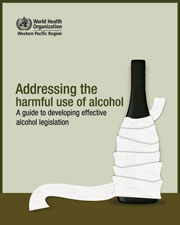
Alcohol, Drugs and Development Strategy
 |
| Sri Lanka: Massive marketing of the multinantional brand "Carlsberg" meets traditional lifestyle in Hikkaduwa. |
| foto: Torkel Edenborg |
This strategy is a part of FORUTs Alcohol, Drugs and Development project.
You may also download the Alcohol, Drugs and Development Strategy as a pdf- document.
Content:
Introduction
Background
Poverty
State revenue
Health
International alcohol industry
Marketing
Social aspects groups
Alcohol Focus
Illegal drugs
Development objectives
Litterature
Introduction
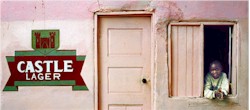 |
| Zambia: Castle Lager by one of the worlds biggest beer companies, SABMiller, is advertised on a wall of a house in Zambia. |
| foto: Camilla Orjuela |
Since 1997 a separate project, Local Action against Alcohol and Drugs, has been run by FORUT. In 2003 the Local Action project was reorganized and launched as the ADD Program; Alcohol, Drugs and Development. Since 1987 FORUT has also supported the Alcohol And Drug Information Centre in Colombo, Sri Lanka. Both projects have received funding from the Norwegian Agency for Development Cooperation.
Networking with its main partner organisations FORUT has been addressing alcohol and drugs in a development perspective. Based on highly qualified knowledge about the consequences of alcohol and drug use and their local context, the project approach has been to develop local strategies for reducing distribution and use of alcohol and drugs. A focus on the corporate drinks industry in the developing world has also been included in the project. The project is aimed towards generating knowledge and experience about the local situation regarding substance abuse and developing culturally sensitive prevention models integrated in FORUTs development projects.
Back to content
Background
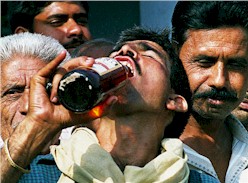 |
| India: A local resident takes a drink from a bottle of locally mnufactured alcohol in haryana, India, after the state government repealed the prohibition order in 1998. |
| foto: AP Photo/Surabh Das |
Alcohol has been in use in most societies for ages. Normally the use of alcohol has been regulated by traditions, social norms and natural limitations. Still, too often we see traditional types of alcohol use representing an alcohol problem in the village or urban setting. This applies to imported or domestic licensed products as well as legal or illegal home brews and home made spirits. New types of alcoholic drinks and drinking patterns will usually come in addition to already existing problems. A survey conducted among secondary school students in Senegal in 1999 shows that experimental use of tobacco, alcohol, cannabis and inhalants were not uncommon among 16-19 years old school students. A relatively modest prevalence for alcohol (around 20 per cent had ever tried it) may be explained by the predominantly Muslim society. Still the study indicates that external cultural influence goes together with increased experimentation and the use of alcohol and drugs among adolescents. In a time where there is a rapid socio-cultural change and increasing cultural globalisation, growth in the use of drugs and alcohol may be expected if counter-measures are not implemented.
Adverse effects of alcohol consumption are well documented in scientific literature. In its work FORUT and its partners have also witnessed these effects at various project locations. The ill effects of alcohol consumption can arise from a single bout of drinking or from the long term effects of alcohol consumption. Health, social and economic effects are all prevalent. Alcohol use is one of the major causes of the global disease burden. The World Health Organisation (WHO) has attempted to estimate the direct and indirect health impact due to alcohol. It states that the increase in alcohol consumption in developing nations where health and economic systems are weakest, is of great concern to WHO. There is a paucity in research material on the role of alcohol in developing countries. Thus further research is necessary to gain better knowledge in this field.
Back to content
Poverty
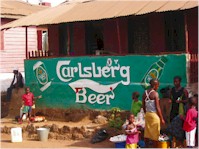 |
| Sierra Leone: Freetown, 2003. Carlsberg beer is one of the biggest multinational beer companies, while Sierra Leone ranges last among the 173 countries at the UNDP Human Development Index for 2002. |
| foto: Terje Heggernes |
Poor people around the globe are vulnerable even to small changes destabilising their daily hand to mouth economy. For those living under harsh circumstances with few possibilities for relaxation, alcohol may seem an easy way out. This is also along the lines of the image portrayed by the alcohol producers – a taste of luxury, recreation and the world beyond everyday worries. But the social, economic, health and other problems created by alcohol use are rather additional burdens for poor people. This has been pointed out by the poor themselves in a WHO and World Bank report from the Voice of the Poor study (“Dying for Change, Poor peoples experience of health and ill-health”). It states that poor people see alcohol and drug use as a major consequence of poverty. Groups and individuals interviewed world-wide mention a pattern of male drunkenness, scarce money spent on alcohol and drugs, and domestic violence.
The study "Alcohol and Drug Use in Nepal, with Reference to Children" done by FORUTs partner Child Workers in Nepal Concerned Centre (CWIN) together with the Tribhuvan University in Kathmandu is the first large scale study generating a national overview in the country. According to the results more than one third of the children (under 18) interviewed identified negative impact of parental drinking. This included domestic violence, loss of wealth, indebtedness, loss of social prestige and a bad relationship with neighbours. Parental drinking is identified as a "push factor" for children running away from home. A study by ADIC in Sri Lanka showed that in some areas of the Colombo slums people spent as musch as one third fo their daily income on alcohol.
Back to content
State revenue
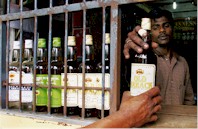 |
| Sri Lanka: A Sri Lankan selling locally made arrack at a liquor shop in Colombo, Sri Lanka. Many places around the world states are dependent on excise from alcohol tax. |
| foto: REUTERS/Anuraddha Lokuhpuarachchi |
The study "Alcohol and Drug Use in Nepal” by CWIN same study highlights that the production of alcohol has drastically increased over the years. The national revenue from alcohol has remained steady for the seven years preceding 2000, exceeding one billion rupees (6% of the total government revenues). Alcohol contributes more than 50 percent to the total excise duty in Nepal. Thus Nepal is one example of a country in a situation similar to many western countries in the early twentieth century, prior to the advent of the income tax, where alcohol is a source of state revenue. Tax, license fee, auctioning of licences and direct income from state run outlets are among the various ways state revenue from alcohol may be collected around the globe.
There are other examples of developing countries being highly dependent on national revenues from alcohol. In some Indian states alcohol makes up as much as 23% of the revenue. Cameroon in 1990 derived 42% of the revenue as taxes from the locally produced beer and soft drink industry while 10% of Kenyas government revenues in 1985 came from alcohol taxes. In other countries alcohol make up a smaller proportion. Sri Lanka earned 4% of its revenue from alcohol taxes in 1996 while on average the twelve countries in the European Union drew 2.4% of revenue from alcohol taxes.
The state dependence on revenue from alcohol tax will not be an incentive to impose restrictions on the advertisement and sale of alcohol and strict enforcement of such restrictions. The country might seek to maximise income, but the social costs of alcohol are often overlooked. These costs include the direct cost of treating injuries and diseases as well as treatment and rehabilitation costs, property loss, law enforcement costs, and losses in productivity due to absenteeism or loss of productive years of life. For a country with great challenges such as malnutrition, contagious diseases, droughts, floods and other problems, an extra problem of alcohol is not needed. If we were to draw up a balance sheet for expenses and income from alcohol in a society it would be appropriate to ask if alcohol is paying its way.
Back to content
Health
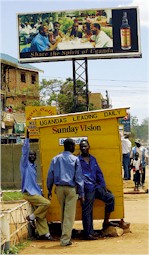 |
| Uganda: "Share the Spirit of Uganda", and advertisment in Kampala. |
| foto: Torkel Edenborg |
According to the global burden of disease study sponsored by the WHO and the World Bank, morbidity from alcohol, measured in years of life lost to disability, has a greater impact on health than even malnutrition or poor sanitation. The study puts alcohols global health impact on par with unsafe sex and above tobacco in terms of its contribution to the total number of years of life lost to death and disability as recorded in the DALY index (Disability Adjusted Life Years).
For poor people good health is a major asset in their struggle to emerge from poverty, but WHO point out that among men in the developing world alcohol ranks as the fourth cause of disability; in the industrialised regions it ranks first. Women often carry the burden of alcohol abuse by men. Domestic violence, broken families, neglected children, a husband falling sick or otherwise disregarding his work, failing to bring income to the family in addition to the money spent on booze – all this is an extra burden for a family whose income is low and insecure. Their family life, childrens schooling, family income and the health of the user are among the factors involved, in addition to more accidents and instances of violence.
Back to content
International alcohol industry
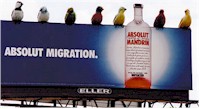 |
| Absolut migration: The marketing of international alcohol brands is a truly global affair. |
| foto: Camilla Orjuela |
The saturation of markets for beverage alcohol in the West combined with a higher industry concentration and increased market power, has led to the expansion of the international alcohol industry in new markets in Africa, Asia and Latin-America. Massive marketing efforts aimed at young people, poorer sections of the population, the affluent middle class and those who already have a high consumption are paving the way for their products. New drinks and drinking habits will often represent an additional problem to those already existing.
The drinks industry has been going through a period of restructuring. New alliances, fewer and bigger companies are the result. Today the ten biggest multinational brewers sell more than one-third of all industrially produced beer in the world. Their share of the global market is increasing. The major beer producers have close to monopoly on their home market, and globally one or two major players dominate each market (Asia, Africa and Latin America). Global spirit brands comprise close to half of the spirits sales world-wide, and ten companies account for more than half of these sales.
The market power of these companies can some times spill over into political power. They are in a position to advise and influence the legislation in the sector they are working. They may also invest in other sectores, like the media industry, in order to further their business. Sometimes even the actors of the alcohol industry involve themselves directly as politicians.
Back to content
Marketing
 |
| Sri Lanka: Carlsberg beer advertised by an elephant mascot in Colombo. |
The alcohol industry is willing to spend heavily on marketing to maintain product image and create barriers to entry for other firms. Throughout the world you find examples of heavy marketing both for local and international brands. Often the companies have licencing and other agreements or they own part of each other. A lot of the commercial are tuned towards new user groups such as young people, women and ethnic groups who traditionally did not drink. Sponsorships of cultural, sports and other events are often used in order to give the companies an image of social responsibility. In at least some developing country markets, the international marketers use campaigns and tactics that would be unacceptable in their home markets.
Back to content
Social aspects groups
 |
| "GOT TO BE GUINNES": In most European countries making health claims about alcohol in advertising is not allowed. Yet in Malaysia, Guinness ran an advertising campaign implying that Guinness improves male fertility. |
| foto: From the brochure "Marketing Alcohol to young People" published by EuroCare 2001 |
Increasingly, the influence of the alcohol industry is exercised through “social aspects organisations”. These are created and sponsored by the beverage alcohol industry to promote its interests, but are often presented to the public as impartial and objective bodies whose sole concern is to tackle the problems of alcohol misuse. These organisations appear to have become a major influence on policy making at international as well as national levels. Compared to most NGOs, social aspects organisations command huge financial resources and spend them to sponsor research, recruiting scientists, hosting conferences and promoting high profile publications (Alcohol and Emerging Markets: Patterns, Problems, and Responses, by the International Centre for Alcohol Policy, ICAP, being one of them). From being a phenomenon in the western world, social aspects groups are now being set up in a number of developing countries and regions along the patterns seen in Europe and America.
Back to content
Alcohol Focus
Institutions and research sponsored by the international alcohol industry point out that heavy drinking, termed alcohol abuse, is the problem, not moderate daily consumption. These researchers call for a focus on alcohol consumption patterns which pertain to how and where alcohol is consumed and in what context the consumption take place. FORUT is focusing on local specifics of alcohol consumption, alcohol problems and the potential for prevention, taking the cultural context into consideration. Still, a large body of evidence from decades of alcohol research supports a correlation between levels of alcohol related problems and levels of per capita consumption in the society. This body of knowledge should not be disregarded but brought into the interpretation of the situation in the local context. This knowledge warrants a view where focus on consumption level still is important.
Back to content
Illegal drugs
Whereas alcohol is a legal substance, illicit drugs also create human suffering in every part of the world. The trafficking in drugs globally has grown to become a major part of global crime and is often seen in areas ravaged by civil unrest and war. A few cultures also have traditional use of drugs, but the use of these substances is now mostly illegal, covered by UN conventions. Drug use is a growing problem in the global community, hitting both in the streets of western metropolises and in the rural poor areas in the south.
Children and youth living on the streets of big cities in the developing world are often seen sniffing various solvents. A study from Child Workers in Nepal (CWIN) published in 2002 shows that this is a common problem among street children in Nepal. Out of 118 children under 16 years interviewed, 43 percent reported to be using glue in various quantity. Reasons reported for taking up the habit were mostly peer influence and pressure. Sniffing solvents has a clear negative long term health effect, but this is not something they are well aware of. They seek the short-term escape from their harsh reality through the hallucinating experience. Effects reported by CWIN are violence and fighting among friends. These children develop a self-destructive nature under the influence of the solvents. Also on the streets of Bangalore, India, where Association for Promoting Social Action (APSA) is working, sniffing of solvents is prevalent. An examination conducted by APSA shows that children with little or no contact with families are more likely to be addicted to substances and for a longer term. Suicidal tendencies and deliberate self-harm and self-mutilation are also seen here. High risk sexual behaviour is also common among the users.
In Sierra Leone the history of civil war, rebellion and brutalities cannot be narrated without recognising the role of drug abuse. The society has witnessed the unspeakable effects of the drug use by rebel forces who committed gruesome crimes, and drugs were seen to be fuelling the war. In the wake of the war, even after the peace agreement, the society is faced with a tremendous challenge in the drug situation. Also in The Gambia FORUT staff experience that marihuana is being grown locally, it is accessible and used particularily by young people. This leads to the youngsters becoming social liabilities, they may be apprehended by the police, they commit crimes, get into fights, show no respect for the elders, create conflicts, do not contribute to their families, break down the family structure, and some go crazy (start hallucinating). The youngsters using marihuana create peer pressure for others.
Back to content
Development objectives
 |
| Network: Building a network among FORUT partners and other agencies is part of the strategy in the Alcohol, Drugs and Development project. This group participated in a network meeting in Nepal in 2001. |
In order to continue integrating alcohol and drugs perspectives in the development work and extending the established network, FORUT will run the project Alcohol, Drugs and Development (ADD). The development objectives will be to:
- contribute to building knowledge and designing activities in FORUT’s six partner countries so as to reduce the consumption of alcohol and drugs, and thereby reduce human, social and economic costs.
- contribute to strengthening the counter forces against the use of alcohol and drugs.
- contribute to mobilising resistance against an expanding alcohol capital.
Target groups and geographical locations
The project relates to FORUTs other activities in all six project countries: Sri Lanka, India, Nepal, Senegal, The Gambia and Sierra Leone through
- raising knowledge and awareness in FORUT project staff and partner organisations
- raising awareness in all target populations (for example rural poor or urban slum population, street children, victims of child exploitation, urban youth, internally displaced people etc).
- raising awareness among development agencies and advocacy groups
Ethical principles and goals
As a starting point for our approach to alcohol issues, FORUT adopts the five ethical principles already adopted by the European Union as recommendations to its member states in the European Alcohol Action Plan:
- All people have the right to a family, community and working life protected from accidents, violence and other negative consequences of alcohol consumption.
- All people have the right to valid impartial information and education, starting early in life, on the consequences of alcohol consumption on health, the family and society.
- All children and adolescents have the right to grow up in an environment protected from the negative consequences of alcohol consumption and, to the extent possible, from the promotion of alcoholic beverages.
- All people with hazardous and harmful alcohol consumption and members of their families have the right to accessible treatment and care.
- All people who do not wish to consume alcohol, or who cannot do so for health or other reasons, have the right to be safeguarded from pressures to drink and be supported in their non-drinking behaviour.
A further base for the work is the UN Convention on the Rights of the Child, which in Article 33 states: "States Parties shall take all appropriate measures, including legislative, administrative, social and educational measures, to protect children from the illicit use of narcotic drugs and psychotropic substances as defined in the relevant international treaties and to prevent the use of children in the illicit production and trafficking of such substances.
Back to content
Litterature:
Room, Robin, et. al.: Alcohol in Developing Societies: a Public Health Approach, Finnish Foundation for Alcohol Studies/WHO, Helsinki, 2002
WHO/World Bank: Voices of the Poor; Dying for Change, Poor peoples experience of health and ill-health, World Health Organization and World Bank, January 2002
WHO: Global Status Report on Alcohol, WHO, Social Change and Mental Health, Substance Abuse Department (WHO/HSC/SAB/99.11), Geneva, 1999
FORUT-sponsored studies:
Eide, Arne H., Ibou Diallo, Ibrahima Thioub & Lajla Blom: Drug use among secondary school students in Senegal, NIS Health Sevices Research, SINTEF Unimed, Oslo, 1999
Dithal, Rupa et. al.: Alcohol and Drug Use in Nepal, With Reference to Children, Child Workers in Nepal Concerned Center (CWIN), Kathmandu, 2001
Dithal Rupa et. al.: Alcohol and Drug Use among Street Children in Nepal, A Study in Six Urban Centres, Child Workers in Nepal Concerned Center (CWIN), Kathmandu, 2002 and
Rai, Abinash, Keshab Prashad Ghimire, Pooja Shresth and Sumnima Tuladhar: Glue Sniffing among Street Children in the Kathmandu Valley, Child Workers in Nepal Concerned Centre (CWIN), Kathmandu, 2002
![]()
![]()
Developed with CustomPublish CMS by Nettinfo AS

